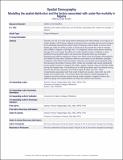Files in this item
Modelling the spatial distribution and the factors associated with under-five mortality in Nigeria
Item metadata
| dc.contributor.author | Fagbamigbe, Adeniyi Francis | |
| dc.contributor.author | Nnanatu, Chibuzor Christopher | |
| dc.date.accessioned | 2022-03-28T23:41:45Z | |
| dc.date.available | 2022-03-28T23:41:45Z | |
| dc.date.issued | 2021-03-29 | |
| dc.identifier | 273873170 | |
| dc.identifier | 80fdc513-efdb-4338-8400-b2aae6eaf02e | |
| dc.identifier | 000634636600001 | |
| dc.identifier.citation | Fagbamigbe , A F & Nnanatu , C C 2021 , ' Modelling the spatial distribution and the factors associated with under-five mortality in Nigeria ' , Spatial Demography , vol. First Online . https://doi.org/10.1007/s40980-021-00078-7 | en |
| dc.identifier.issn | 2164-7070 | |
| dc.identifier.other | RIS: urn:3754E0FAC6A276D3FC1FE76A640603E6 | |
| dc.identifier.other | RIS: Fagbamigbe2021 | |
| dc.identifier.uri | https://hdl.handle.net/10023/25121 | |
| dc.description.abstract | Globally, the risk of a child dying before celebrating their fifth birthday is still high at 5.3 million deaths in 2018 alone. Nigeria is among the few countries that are yet to achieve the Sustainable Development Goal Target of keeping under-5 death to as low as 25 deaths per 1000 live births by 2030. A recent study found that the under-5 mortality rate in Nigeria is still high with 1 in 8 Nigerian children dying before reaching the age of 5. In this study, the effect of a child’s spatial location in Nigeria on their likelihood of dying before age 5 was examined alongside other key covariates. Bayesian geo-additive regression models were fitted to the 2018 Nigeria Demographic and Health Surveys data. Statistical inference was based on the Bayesian paradigm via Markov chain Monte Carlo simulation methods, and models were assessed using the deviance information criterion. Under-five mortality rate varied significantly across spatial locations in Nigeria with Kebbi, Jigawa, Kaduna, Kogi and Gombe states having the highest rates. The likelihood of a child dying before age 5 increased among women with primary education and women aged 38 years and over. Other characteristics associated with high under-5 death are poverty, male child, low birth weight and multiple births. The current study has helped to identify geographical ‘hotspots’ as well as the key factors driving under-5 deaths in Nigeria to inform the effective design and implementation of timely and efficient interventions. | |
| dc.format.extent | 28 | |
| dc.format.extent | 1839435 | |
| dc.language.iso | eng | |
| dc.relation.ispartof | Spatial Demography | en |
| dc.subject | RA0421 Public health. Hygiene. Preventive Medicine | en |
| dc.subject | 3rd-DAS | en |
| dc.subject | SDG 3 - Good Health and Well-being | en |
| dc.subject | AC | en |
| dc.subject.lcc | RA0421 | en |
| dc.title | Modelling the spatial distribution and the factors associated with under-five mortality in Nigeria | en |
| dc.type | Journal article | en |
| dc.contributor.institution | University of St Andrews. School of Medicine | en |
| dc.contributor.institution | University of St Andrews. Population and Behavioural Science Division | en |
| dc.identifier.doi | 10.1007/s40980-021-00078-7 | |
| dc.description.status | Peer reviewed | en |
| dc.date.embargoedUntil | 2022-03-29 |
This item appears in the following Collection(s)
Items in the St Andrews Research Repository are protected by copyright, with all rights reserved, unless otherwise indicated.

